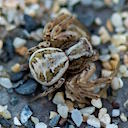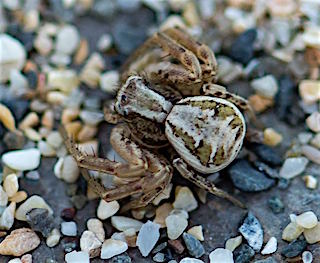 This little crab spider was spotted scuttling across the beach at Church Cove, near Gunwalloe, but they can be found in many habitats, especially open, undisturbed ground.
This little crab spider was spotted scuttling across the beach at Church Cove, near Gunwalloe, but they can be found in many habitats, especially open, undisturbed ground.
Photo: Amanda Scott
Scientific name: Xysticus cristatus
Other common names: Ground Crab Spider
What to look for:
• Family: Thomisidae
• Colouring and appearance: Brown to grey, greenish and black colouring. Darker triangle on carapace, and paler central band down abdomen, with darker triangular markings to either side.
• Size: Length, females up to 8 mm, males up to 5 mm.
• Where: Across the UK, and widespread in western and central Europe.
• When: Mostly from spring through to late summer, peaking in May and June, although adults have been recorded as early as February and as late as December.
 The Common Crab Spider is a sunlight-lover. Although it can be found in many different habitats, you are much more likely to find it scampering across open, disturbed ground or unshaded grassland than in woods or hedges. With its long front legs and the way it sometimes scuttles sideways, it is easy to see how the species gets its common name.
The Common Crab Spider is a sunlight-lover. Although it can be found in many different habitats, you are much more likely to find it scampering across open, disturbed ground or unshaded grassland than in woods or hedges. With its long front legs and the way it sometimes scuttles sideways, it is easy to see how the species gets its common name.
Xysticus cristatus is in fact one of several species in the Thomisidae family called a crab spider. Another species, Misumena vatia – the Flower Crab Spider – is familiar to us, perched on flowerheads and camouflaging itself by subtle shifts in colour. All crab spider species are ambush predators. Rather than spinning webs to catch their food, they lie in wait and then jump on their invertebrate prey as it passes by. The Common Crab Spider doesn’t have the same ability as M. vatia to shift its colour, but it uses the same ambush technique, sometimes perched amongst the grass, or lurking at ground level. It kills its prey – which is quite often larger than the spider – by grabbing it with its long front legs and then biting to inject its venom.
Did you know…?
…The male Common Crab Spider mates with the female by first taking hold of one of her legs and then tying her to the ground with silken threads, before crawling beneath her in order to mate.
Published: June 2016
Author: Amanda Scott
Photos: Amanda Scott
